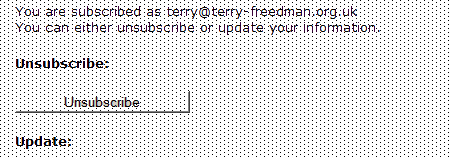I’ve recently decided to finally take the bull by the horns and unsubscribe myself from any newsletter or other mailing that I don’t at least skim on its arrival. It’s part of a drive to de-junk my life, starting with our home, and moving on to my inbox. You’d think that unsubscribing would be easy. Unfortunately, that’s not always the case.
There are three main ways that an unsubscribe request can be handled. One is an instant, no barrier, response. Another is the opposite, where it is actually time-consuming or otherwise difficult. Yet another is a halfway house between these two extremes, in which you’re asked to confirm that you really do want to leave the list, perhaps by entering your email address into a form and then clicking a button.
Let’s take that last one first. In principle, I suppose that’s the best. It’s possible that a vindictive or mischievous person could unsubscribe you from various lists if you were daft enough to leave your computer unattended while your email was open. I suppose it’s also possible that you could accidentally unsubscribe yourself from the wrong list. I can’t help feeling, though, that it’s both unnecessary and ineffective, because if someone was acting mischievously or if you were absent-minded, nothing as simple as confirming your email address would prevent your going ahead.
But then there are the ones that really don’t want you to unsubscribe, and will resort to ridiculous measures to try and stop you. For instance, there was one where the unsubscribe link is in a tiny font, in dark blue, on a black background. I suppose the idea is that if you can’t actually find the unsubscribe link, you can’t click on it.
There are others where you have to log in, for which you may have to remember your password for a site you first registered at 10 years ago. I know there’s always the “Forgot your password?” link, but it’s extra hassle, for no good reason.
There are others that force you into giving a reason for unsubscribing before they let you do so. I always click on the first thing in the drop-down list, if there is one, or put a space (which is, of course, a character) in the text box if there isn’t. The reason is that if I’m unsubscribing I don’t want to have to spend more time than I have to doing so.
There are even some who have no unsubscribe link at all. In the USA, as far as I know, and in the EU, it is illegal not to include one.
And then there are some which fire back a message to the effect that it will take a week for the unsubscribing to take effect. What? Have they got some part-timer going through them all by hand? The process should be instant.
And so we come on to the first type I mentioned. I was pleased when, recently, I unsubscribed from Stephen Downes’ OLDaily newsletter, because I discovered that I had inadvertently subscribed under two different email addresses, that the process took seconds, which is how it should be.
Unsubscribing from my newsletter is equally fast, with the small addition of the fact that a short confirmation email is sent saying:
Hi
Just a quick note to say that you've successfully unsubscribed from the Computers in Classrooms newsletter.
If you have a moment, it would be really appreciated if you could drop me a quick email to let me know why.
Thank you very much
Best wishes
Terry Freedman
Sometimes I receive a response, sometimes not. I never pursue non-responders, and only reply to responders to say “thanks”.
 Unsubscribing should be as easy as clicking a button
Unsubscribing should be as easy as clicking a button
Why make it so easy for people to unsubscribe? The way I see it, if someone has decided that my newsletter is not for them, the least useful thing I could do would be to find ways of making it hard for them to leave the list, or to continue getting stuff from a me for up to a week afterwards. It would simply annoy them, and that is the kind of word-of-mouth publicity that is worse than useless. It is also pointless from another point of view: where’s the value in having a list with 10,000 subscribers, most of whom never open the mailings?
Here’s my message to those list managers that seem to want to cling onto subscribers, come what may and regardless: respect your readers’ decision to leave the list if they want to. Be swift and courteous about it. Do it with good grace, and don’t put barriers in their way.
Why not subscribe to Computers in Classrooms, the free e-newsletter for people with a professional interest in educational ICT.
